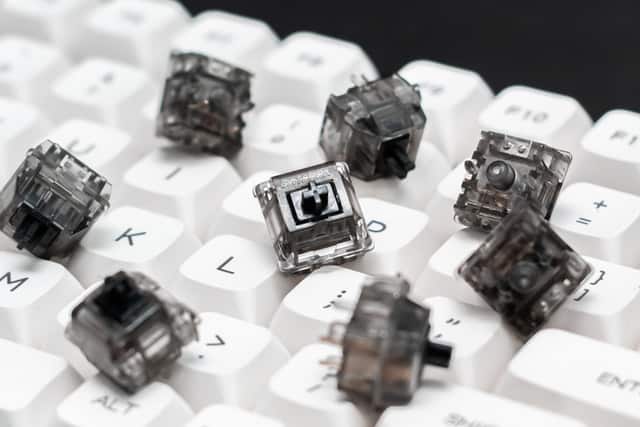Every user struggles to get used to a new device, especially when switching from a membrane to a mechanical keyboard.
The mechanical key’s shapes are slightly different, and the switches underneath produce a unique tactile response that takes time to familiarize.
Therefore, getting used to a mechanical keyboard may take some relearning.
You can get used to a new mechanical keyboard by analyzing the difference between the old and new keys’ layout and size and gradually practicing typing to increase speed.
After some practice, you are guaranteed to ace using a mechanical keyboard. Follow this guide to learn how to quickly get used to a new mechanical keyboard.
Table of Contents Show
Why Switch to a Mechanical Keyboard?
The mechanical keyboard is unlike its counterparts. It is easier, offers a quick response, and lasts longer.
Although in use since the 1980s, a mechanical keyboard is rarely seen in-home or in offices because it is slightly expensive.
However, there is a good reason for it.
A quality mechanical keyboard has a lifespan of 50-60 million clicks per switch, while a membrane keyboard would last only 5-6 million clicks.

Moreover, it employs a hard-plastic or mechanical switch underneath every key to provide a more accurate and quick response to each key press.
Switching to a mechanical keyboard has many advantages that benefit both regular and casual users.
Here are a few reasons to switch to a mechanical keyboard pronto!
1. It Lasts Longer
The prolonged life expectancy alone would be enough to buy a mechanical keyboard.
A regular keyboard may take a lot of heat from users that will cut its life short, requiring buying a new one every 1-2 years or even lesser.
On the other hand, a standard mechanical keyboard will last you around 10-15 years because it is built for durability.
A typical mechanical keyboard offers at least 50 million clicks per switch which may take years to cover.
It is also robustly designed to keep every piece intact after frequent wear and tear.

2. It Offers a Quicker Response
The mechanical keyboard employs a switch underneath every key and does not have a rubber layer found in membrane keyboards.
A rubber layer prolongs the time for the keypress to travel to the CPU (Central Processing Unit).
However, a mechanical key has a mechanism that directly sends the input to the CPU, reducing the response time.
It takes around a 6ms response time to register a press in the mechanical keyboard (a blink of an eye takes around 100ms).
On the other hand, a membrane keyboard may take 30+ ms.

3. Greater Tactile Feedback
A mechanical keyboard offers excellent tactile feedback.
Each keystroke registers without bottoming down, which you would know by a clicky sound made halfway through the keystroke.
You are less likely to make typos when using a mechanical keyboard. Also, the clicky sound would tell you early whether the keystroke has been registered or you want to make your keyboard quiet, making it easier to learn to type.

4. It Offers Customization
Mechanical keys can be customized according to your preference. Because of its mechanical makeup, you can pull out each key and replace it with another without damaging the unit.
The ability to replace individual keys means you need not throw away the unit when one key stops working.

5. Great for Some Professions
Because of the more significant tactile response, low latency, and durability, it can be helpful to a few professions.
The typist who spends a significant amount of time on the keyboard can type faster without making many errors.
Gamers who spend significant time pushing particular keys (W, A, S, D) will benefit from higher clicks per switch on a mechanical keyboard.
Similarly, those who use a keyboard more often benefit from a long-lasting and comfortable-to-use mechanical keyboard.
Find out whether a gaming mechanical keyboard will be better for typing.
Why is it Hard to Get Used to a Mechanical Keyboard?
Users who have never used a mechanical keyboard may struggle to get used to it at first. It takes time for their muscle memory to be registered on the new keypad.
It is mainly because a mechanical keyboard offers additional tactile feedback and response that takes a while to register in the brain.
A membrane keyboard employs more like a pressure pad with outlines and symbols used as buttons.
Moreover, most users start their typing journey with a membrane keyboard because it is cheaper and found on most laptops.

Others may use a keyboard with flat keys that offer a different tactile response and feel.
Also read: Are Mechanical Keyboards Ergonomic?
How Long Does it Take to Get Used to a New Mechanical Keyboard?
A Reddit user points out it may take a few weeks to a month to familiarize myself with a mechanical keyboard.
Most mechanical switches are lighter than most membrane keyboards, so you will want to learn to type correctly.
Those with a laptop that has a mechanical key, which is quite rare, can start typing on the laptop itself.
Hence, getting your brain to relearn typing on an entirely new keyboard takes a while.
Also read: Should You Tilt Your Keyboard While Typing?
How to Get Used to a New Mechanical Keyboard?
As mentioned before, it may take a few weeks before you get entirely used to a new mechanical keyboard. However, it would help if you made efforts to learn the new keyboard.
Here are some proven tips to help you adjust to the new keyboard.
1. Analyze Old and New Keyboard
Start with observing the differences between your old and new keyboard to figure out how to work around them.
The most telltale differences you could tell would be the key’s shapes and sizes, imprints, new buttons, and the keyboard’s size and style (compact or full-keyboard).
Some lead differences may only be felt after using the device, such as a bump, tactile feedback, ease of use, sound, and response time.
Because of their mechanical build, the key’s shapes and sizes may be slightly bigger, making few errors when pressing a key.
Not all keyboards carry new buttons. If it does, you can always consult with the seller. Pressing the mechanical key will feel easier on your finger because you need not push it down.
2. Practice Regularly
Acing a new keyboard may take some practice. However, you better do it regularly than seldom.
The only way to familiarize a new keyboard is through typing; hence, the more you type on it, the more you will feel.
It may come quickly to writers who spend significant time typing on the any keyboard, but others may not have such a privilege.
Therefore, care to spend more time on your new keyboard.
According to Typing Academy, a user should plant regular exercise times every day by spending at least one hour.

You can gradually up your typing time to learn to type quickly and smoothly.
If you are wondering, you can use applications like Notepad, Microsoft Word, Google Docs, or interactive typing software like Typing Master to type on.
3. Improve Your Typing Skill
Along with regular practicing, strive to type faster to improve your writing. The command over the keyboard is often signified by your typing speed and the number of errors you would make.
When you can type faster without making errors, you will know you have aced your typing game!
| Words Per Minute | Rating |
|---|---|
| 0 - 4 | Novice |
| 4 - 10 | Slow |
| 10 - 20 | Satisfied |
| 20 - 40 | Good |
| 40 - 60 | Very good |
| 60 - 100 | Excellent |
| 100 - 160 | Unbeatable |
| Over 160 | Legendary |
Another way to improve typing skills is to learn to type without looking at the keyboard. This will help you get the hang of the new device.
Many video tutorials and software will help you master typing without looking.
Read our article about how to type without looking at the keyboard
Also watch,
4. Enjoy the Process and Have Patience!
The key to successfully familiarizing a new keyboard is some patience. Starting anything new takes some time; familiarizing a new keyboard is no different.
Have some patience and enjoy the process of learning smoothly.
Tabithaemma, a brand designer, points out that you have won before you have even started if you enjoy the process. To be passionate about something, you do it no matter the outcome.
It would help if you enjoyed typing on it, no matter the outcome.
Also read: Is it Inappropriate to Type on Keyboard with Two Fingers?
Comfortable Mechanical Keyboard in 2025
The best mechanical keyboard will provide a comfortable work experience and encourage productivity with minor damage.
Here is a list of a few mechanical keyboards that will be great for many users.
| Mechanical Keyboard | Feature |
|---|---|
| 1. CHERRY G80-3000 Mechanical Keyboard | - Quick actuation time and smooth operation. -Two-shot molding method -Silent keys with long gaming sessions |
| 2. Logitech G513 Mechanical Keyboard | - SilentTouch technology to eliminate over 90% of distracting noises -spill-resistant construction, long-lasting keys, and robust tilt legs |
| 3. CORSAIR Strafe MK.2 Mechanical Keyboard | -Silent Cherry MX red switches -Full key rollover -RGB lighting |
| 4. Filco Majestouch 2 TKL Mechanical Keyboard | -Cherry MX Brown Silent switches -Keycaps with black padded printed ABS |
| 5. SteelSeries Apex M750 Mechanical Keyboard | -Cherry MX Silent Switches -Omnipoint Adjustable switches -OLED Smart Display |
| 6. Das Keyboard 4 Mechanical Keyboard | -Thinnest Mechanical Keyboard -Silent Cherry MX Brown switches -Keycaps with laser etching for optimal durability |
| 7. Razer BlackWidow Elite Mechanical Keyboard | -Razor Silent Green switches -Chroma RGB lighting -Doubleshot ABS Keycaps |
| 8. Corsair K100 RGB | -Responsive optical switches -All the RGB, all the time -Premium build quality |
| 9. Ducky One 2 RGB TKL | -Silky stabilizers -High-quality keycaps -Surprisingly affordable |
| 10. Fujitsu Realforce R2 RGB | -Smooth as butter Top switches -Adjustable actuation point -Media controls |
Also read: Can a Computer Keyboard Break Easily?
Final Verdict
You can easily ace the mechanical keyboard with practice, but it may take a while to get used to!
Rest assured, a quality mechanical keyboard will last around 10-15 years, saving you a lot of money in the future.
Have some patience and follow this guide to find the best tips about familiarizing yourself with your mechanical keyboard.
Related Article: How to Type Quietly on Mechanical Keyboard?


